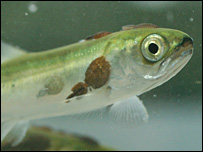| Wild salmon on Canada's west coast are being driven to extinction by
parasites from nearby fish farms, a study claims. Wild pink
salmon around the Broughton Archipelago are declining rapidly and will die out
within 10 years if no action is taken, say researchers. They say the data,
published in Science, raises serious concerns about the global expansion of
aquaculture. Sea lice from farms are known to infect wild salmon, but until now
the impact on wild populations has been uncertain. "The impact is so
severe that the viability of the wild salmon populations is threatened,"
said lead researcher Martin Krkosek from the University of Alberta in Edmonton,
Canada. Modelling studies
Dr Krkosek and colleagues compiled data on the numbers of pink salmon in rivers
around the central coast of British Columbia. They compared populations of
salmon that had come into contact with salmon farms with those that had not
been exposed, from 1970 to the present day. Using a mathematical model of
population growth rates, they show that sea lice from industrial fish farms are
reducing the numbers of wild pink salmon - a Pacific salmon species - to the
extent that the fish could be locally extinct in eight years or less. Dr
Krkosek said the population growth rate was "severely depressed". "It
means that the probability of extinction is 100% and the only question is how
long it is going to take." Natural parasites
Scientists say commercial open-net salmon farms are a "haven" for sea
lice - naturally occurring parasites that attach to the skin and muscle of
salmon. Mature fish can survive being infested by a few lice but tiny juvenile
salmon are particularly vulnerable to attack. They come into contact with sea
lice when they swim past fish farms on their migratory routes from rivers to
the sea.
"Salmon farming breaks a natural law," explained study co-author
Alexandra Morton, director of the Salmon Coast Field Station, located in the
Broughton Archipelago. "In the natural system, the youngest salmon are not
exposed to sea lice because the adult salmon that carry the parasite are
offshore. But fish farms cause a deadly collision between the vulnerable young
salmon and sea lice. They are not equipped to survive this, and they
don't." 
(Image courtesy of Alexandra Morton)
Scientists say there are a number of solutions to
the problem, including moving farms away from rivers used by wild salmon or
putting farmed salmon in pens that are completely sealed off from the
surrounding environment. "The most obvious thing to do is to move the farm
out of the way of the wild fish," Dr Krkosek said. "Don't put them on
the migration route, and don't put them near the spawning rivers. Another
option is to move to closed containment technology where the net pen is
replaced with a physical barrier that prevents the exchange of parasites - that
would solve the problem too." National treasure
Dr Krkosek said the impact of fish farms on wild
salmon has been "an emotionally, politically and economically charged
debate" in Canada. "Salmon are considered a natural treasure to
Canadians, but salmon farming has a lot of economic opportunity - we really
need economic activity to supplement coastal economies where fisheries and
other resource centres are not doing as well," he explained. "So
there are economic benefits to having salmon farms, but the way that it is
currently being done is very damaging to the environment and there are better
ways of doing it." The report in Science has implications for other parts
of the world where salmon is farmed, such as Norway and Scotland. Other species
of salmon are known to become infected with sea lice, but they vary in their
ability to withstand this.
Source: BBC-Science (Helen Briggs) | 
